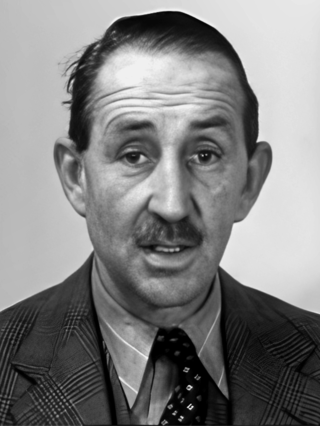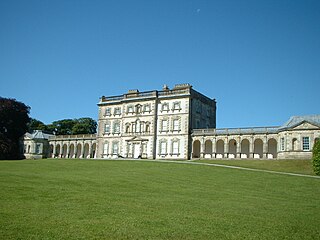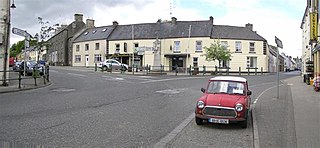Related Research Articles

County Fermanagh is one of the thirty-two counties of Ireland, one of the nine counties of Ulster and one of six counties of Northern Ireland.

County Monaghan is a county in Ireland. It is in the province of Ulster and is part of Border strategic planning area of the Northern and Western Region. It is named after the town of Monaghan. Monaghan County Council is the local authority for the county. The population of the county was 65,288 according to the 2022 census.

Basil Stanlake Brooke, 1st Viscount Brookeborough,, styled Sir Basil Brooke, 5th Baronet, between 1907 and 1952, and commonly referred to as Lord Brookeborough, was an Ulster Unionist Party (UUP) politician who served as the third Prime Minister of Northern Ireland from May 1943, until March 1963.

Viscount Hardinge, of Lahore and of Kings Newton in the County of Derby, is a title in the Peerage of the United Kingdom. It was created in 1846 for the soldier and Tory politician Sir Henry Hardinge. His son, the second Viscount, represented Downpatrick in Parliament. His great-great-grandson, the sixth Viscount, succeeded a distant relative as eighth Baronet, of Belle Isle in the County of Fermanagh, in 1986. This title had been created in the Baronetage of the United Kingdom 1801 for Richard Hardinge. He was the third son of Nicolas Hardinge, younger brother of Reverend Henry Hardinge and uncle of the latter's third son Henry Hardinge, 1st Viscount Hardinge. The baronetcy was created with special remainder to the heirs male of Richard Hardinge's father.

Brookeborough is a village in County Fermanagh, Northern Ireland, at the westerly foot of Slieve Beagh. It lies about eleven miles east of Enniskillen, just off the A4 trunk road, and about five miles west of the County Tyrone boundary. It is situated in the civil parish of Aghavea and the historic barony of Magherastephana. It is situated within Fermanagh and Omagh district.

Castle Coole is a townland and a late-18th-century neo-classical mansion situated in Enniskillen, County Fermanagh, Northern Ireland. Set in a 1,200-acre (490 ha) wooded estate, it is one of three properties owned and managed by the National Trust in County Fermanagh, the others being Florence Court and the Crom Estate.

Florence Court is a large 18th-century house and estate located 8 miles south-west of Enniskillen, County Fermanagh, Northern Ireland. It is set in the foothills of Cuilcagh Mountain. The nearby village is distinguished by the one-word name Florencecourt. It is owned and managed by the National Trust and is the sister property of nearby Castle Coole. The other National Trust property in County Fermanagh is the Crom Estate.

Glynn is a small village and civil parish in the Mid and East Antrim Borough Council area of County Antrim, Northern Ireland. It lies a short distance south of Larne, on the shore of Larne Lough. As of the 2011 census, the Glynn ward had a population of 2,027 people.

Pettigo, also spelt Pettigoe, is a small village and townland on the border of County Donegal, Republic of Ireland, and County Fermanagh, Northern Ireland. It is bisected by the Termon River which is part of the border between the Republic of Ireland and Northern Ireland.

Cave Hill or Cavehill is a rocky hill overlooking the city of Belfast, Northern Ireland,with a height of 368 metres (1,207 ft). It is marked by basalt cliffs and caves, and its distinguishing feature is 'Napoleon's Nose', a tall cliff resembling the profile of the emperor Napoleon. On top of this are the remains of an ancient promontory fort called McArt's Fort. Cavehill was also historically called 'Ben Madigan', after a king of Ulster called Madagán.
The Crom Estate is a nature reserve located in the south of County Fermanagh, Northern Ireland, along the shores of Upper Lough Erne. It is one of three estates owned and managed by the National Trust in County Fermanagh, the others being Florence Court and Castle Coole mansions. The estate comprises 1,350 acres (5.5 km2), composed primarily of riparian forest. Some trees are so ancient that physical access is restricted.

Donegal Castle is a castle situated in the centre of Donegal Town in County Donegal in Ulster, the northern province in Ireland. The castle was the stronghold of the O'Donnell clan, Lords of Tír Conaill and one of the most powerful Gaelic families in Ireland from the 5th to the 16th centuries. For most of the last two centuries, the majority of the buildings lay in ruins but the castle was almost fully restored in the early 1990s. It is now open to the public.

Lissadell House is a neo-classical Greek revivalist style country house in County Sligo, Ireland.
Sir Ralph Gore, 4th Baronet was a Speaker of the Irish House of Commons. He is now chiefly remembered for building Belle Isle Castle.
Crom Castle is a country house on the shores of Upper Lough Erne in County Fermanagh, Northern Ireland, the seat of the Earls Erne. Standing within the 1,900-acre (7.7 km2) Crom Estate, and within a formal garden, the castle is built in stone. A central battlemented tower includes the main entrance, and there are also smaller towers to one side. It stands apart from the ruins of Old Crom Castle, of which two towers, some walls, and a ha-ha survive, and near them two ancient yew trees, believed to be at least 800 years old.

General The Rt Hon. Ralph Gore, 1st Earl of Ross, known as Sir Ralph Gore, 6th Baronet, from 1746 until 1764, subsequently as The Baron Gore until 1768, and then as The Viscount Belleisle until 1772, was an Anglo-Irish soldier, politician and peer.
The High Sheriff of Fermanagh is the Sovereign's judicial representative in County Fermanagh. Initially an office for lifetime, assigned by the Sovereign, the High Sheriff became annually appointed from the Provisions of Oxford in 1258. Besides his judicial importance, he has ceremonial and administrative functions and executes High Court Writs.
The High Sheriff of Tyrone is the Sovereign's judicial representative in County Tyrone. Initially an office for lifetime, assigned by the Sovereign, the High Sheriff became annually appointed from the Provisions of Oxford in 1258. Besides his judicial importance, he has ceremonial and administrative functions and executes High Court Writs.
Blessingbourne House is a large Elizabethan style manor-house situated in parkland near Fivemiletown in County Tyrone, Northern Ireland.

Earl of Arran is a title in the Peerage of Ireland. It is not to be confused with the title Earl of Arran in the Peerage of Scotland. The two titles refer to different places: the Aran Islands in Ireland, and the Isle of Arran in Scotland. The Irish earldom is held by the Gore family. The Scottish earldom is a separate title, held as a subsidiary title of the Duke of Hamilton.
References
- ↑ Robert Bell, The Book of Ulster Surnames, p. 175. The Blackstaff Press, Belfast, 1988 (2003 reprint).
- ↑ Brian G. Scott (General Editor), Claire Foley and Ronan McHugh, An Archaeological Survey of County Fermanagh: Volume I, Part 2 - The Early Christian and Medieval Periods, pp. 349 and 698. Northern Ireland Environment Agency (N.I.E.A.), Belfast, and Colourpoint Books, Newtownards, 2014.
- 1 2 Tours, Tenon. "Belle Isle Castle S/C". Archived from the original on 3 April 2014. Retrieved 3 April 2014.
- ↑ "Belle Isle Cookery School". Archived from the original on 3 November 2015. Retrieved 3 April 2014.
- ↑ "Belle Isle". © Belle Isle 2014. Retrieved 3 April 2014.